Christopher Snowdon's Blog
November 28, 2025
The WHO's "best buys" for alcohol
I've written a briefing for Epicenter off the back of this year's Nanny State Index about the WHO's so-called "best buys" for alcohol. These are the policies that are supposedly most cost-effective in cutting alcohol-related harm. As I show, there is scant evidence that they are effective at all, and they are certainly neither a sufficient nor necessary way of dealing with the problem.
Download it here or read a slightly modified version on my Substack.
November 25, 2025
What happened at COP11?
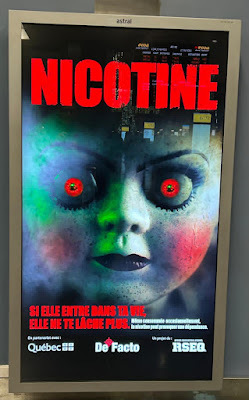 Speaking of a compliant media, here's how
Health Policy News
explains the flop that was COP.
Speaking of a compliant media, here's how
Health Policy News
explains the flop that was COP. ‘Unprecedented Levels of Industry Interference’ Stalls Decisions on New Tobacco Products and Pollution at UNFCTC COP11'Industry interference', the deus ex machina of "public health". It's just so tedious. This conference, like the even more expensive climate ones, are simply a waste of time. As David Zaruk says, "as long as the organizers are beholden to the zealots and billionaire prohibitionists, no one will notice and fewer delegates will bother attending or contributing." Read his account and check out the musings of Maria Papaioannoy (pictured with me at Good COP below) here. And read my article from this weekend's IEA newsletter.
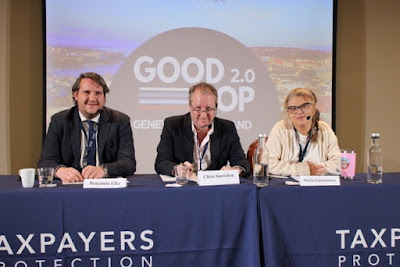
November 21, 2025
The WHO is a billion dollars in the red
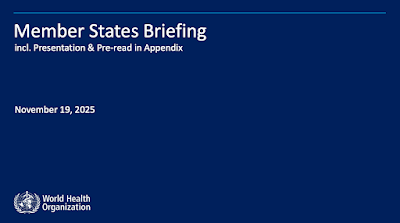
Among the many lowlights at this year's WHO anti-nicotine shindig was the Framework Convention Alliance giving New Zealand the Dirty Ashtray award for repealing the ludicrous generational tobacco ban while giving Mexico the Orchid Award for making a speech about how ghastly the tobacco industry is. New Zealand's smoking rate has been falling fast and is now one of the lowest in the world. Mexico's smoking rate has been rising.
But Mexico banned e-cigarettes this year and that's good enough for the WHO. In tobakko kontrol, it's process and intentions that count, not outcomes. (See this article for the hilarious response of Beowulf scholar turned "public health" expert Janet Hoek to New Zealand's "national shame".)
The poor old WHO isn't doing too well these days. In a document circulated to member states, it says that it has a $1.06 billion shortfall and is having to make cuts. They include:
2,371 job losses and a 28% reduction in headcount. The WHO's Regional Office in Africa is bearing the brunt (who cares about Africa, eh?) with a 25% reduction in staff, but Europe is not far behind with 24%.
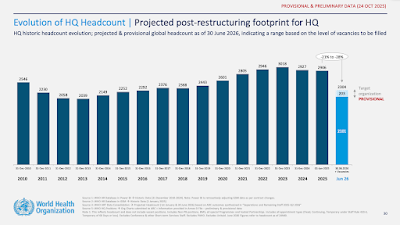
The WHO's leadership team was reduced by around 50% in June.
The number of WHO units will be cut from 206 to 127.
The Assistant Director-General post on Universal Health Coverage, Communicable and Noncommunicable Diseases has been abolished. 'NCDs' are now the responsibility of Britain's Jeremy Farrar who is a good fit for the WHO because he likes sucking up to China.
Monika Kosinska, who was WHO's Cross-Cutting Lead for Economic and Commercial Determinants of Health (the ultimate non-job?), is now WHO Global Technical Lead on Social Determinants and Health Equity. Long time readers might recall Monika from her days at the European Public Health Alliance, which is also in turmoil these days. Jinx?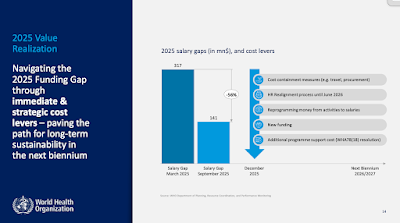
The WHO says that it aims to "build on assessed contributions, diversify funding sources, and streamline grant management through technology". Don't be surprised if Bloomberg steps up with some more cash to tighten his stranglehold on the organisation.
Meanwhile, the New Zealand government has cut the budget of its temperance groups. I'll drink to that.
Have a great weekend!
"Good riddance" is not an economic policy
Read the rest at The Critic .
Sky Bet is relocating to Malta where it can enjoy an effective corporation tax rate of around 5 per cent rather than the 25 per cent it is currently paying in Leeds. The move comes after months of lobbying for higher gambling taxes and credible rumours that Rachel Reeves will increase remote gambling duty in next week’s Budget. Gambling operators cannot avoid paying duty on the Gross Gambling Yield generated by customers in the UK (which is essentially revenue, not profit), but they don’t have to be headquartered in the UK.
Since most gambling companies are based offshore and the government has done nothing to dampen talk of remote gambling duty going up from 19 per cent to 25 per cent or more, it should have taken no one by surprise when Sky Bet decided to flee the country. And yet the Chair of the Treasury Select Committee, Meg Hillier MP, was completely blindsided. “I’m pretty astounded,” she told ITV News. “The betting industry appeared in front of the Treasury Select Committee just a couple of weeks ago, extolling the virtues about how much tax they’re paying in the UK. And here we see a company going and offshoring. It rather takes the biscuit doesn’t it?”
The Betting and Gaming Council (BGC) did indeed appear before her committee last month, as I reported at the time, but it takes a tin ear to think that they were merely boasting when they explained that their members pay an effective tax rate of between 65 per cent and 80 per cent. They explicitly said: “The BGC’s role is to highlight to the Committee and the Treasury the negative impacts of any additional tax rises on the whole of the betting and gaming industry and the jobs it supports.” Mrs Hillier apparently misheard this as: “We pay lots of tax and would be delighted to pay some more.”
November 16, 2025
COP 11 starts this week
The WHO’s big biennial tobacco conference kicks off this week in Geneva. A global tobacco conference wouldn’t be a bad idea right now. In a sane world, governments would be getting together to discuss how things are going so badly wrong and how to correct their mistakes.
Led astray by fanatics, a growing number of countries are seeing unintended consequences that are too disastrous to deny. Australia is the most dramatic example, but the black market in tobacco in Britain is also now a major source of criminal activity. Here are just some of the BBC stories from the last month involving the illegal sale of cigarettes:
Mini market closed after illegal cigarettes seized
Man jailed over illegal cigarettes and tobacco
£30,000 of illegal tobacco and vapes seized
Illegal vapes and cigarettes worth £60,000 seized
Illegal goods worth £280k netted in city shop raids
Arrests made and goods seized in police raids
Mini-mart crime network a ‘pull factor’ for illegal migrants, say MPs
Illicit cigarettes found under fake shop floors
Hundreds arrested in High Street crime crackdown
High Street action uncovers £75k of illegal goods
In countries such as France and the Netherlands, the illicit trade is similarly spiralling out of control. In Eastern Europe, balloons are being used to smuggle tobacco into neighbouring countries. In India, a WHO-approved ban on vapes has predictably led to a “rampant unregulated gray/black market”.
Tobacco duty receipts are declining, but in many countries smoking rates are holding steady. In the EU, the smoking rate has barely budged in a decade.
Faced with the consequences of its own actions, the anti-smoking lobby has shoved its head deeper into the sand. The secretariat for the Framework Convention on Tobacco Control (FCTC) has set out its stall for the eleventh Conference of the Parties (COP 11) by proposing some “forward-looking measures” that are just different flavours of prohibition. The real solution is to make smoking reasonably affordable while encouraging the use of low and ultra-low risk nicotine products like pouches and vapes. Instead, under the influence of Mike Bloomberg’s billions, they are demanding ludicrous policies such as putting health warnings on individual cigarettes and banning cigarette filters.
A newly minted tobacco control lie is that the very concept of harm reduction is the invention of the “nicotine industry” and that harm reduction is an “industry narrative”. This is now the line that loyal foot soldiers must take, despite the WHO’s definition of tobacco control being…It is hard to believe that the WHO will get away with this shameless volte-face but through sheer repetition they will probably achieve it. Expect to hear this lie repeated again and again during COP 11 until it becomes the new truth.“a range of supply, demand and harm reduction strategies that aim to improve the health of a population by eliminating or reducing their consumption of tobacco products and exposure to tobacco smoke”.
The WHO is no longer very interested in reducing people’s “consumption of tobacco products”. It is now focused on reducing people’s consumption of products that contain no tobacco, do not produce “tobacco smoke”, and are substitutes for tobacco products. It is debatable whether this is even within the remit of the Framework Convention on Tobacco Control - given the WHO’s own definition of “tobacco control” - but it is certainly counter-productive and a threat to individual liberty. As I argued recently, it is quite possible that there would be fewer smokers around today if there had never been an anti-smoking movement.
As with the last two COP meetings, I will be in town with an impressive array of experts to have a reality-based discussion about what governments should do to heal their self-inflicted wounds, cut crime and improve health. The public and media are always banned from attending the conference (!), and it is anyone’s guess who will be on the UK’s delegation, but we’ll be doing our best to report on what’s happening and will be live-streaming a series of interviews and panel discussions throughout the week, so keep an eye on YouTube if this is your kind of thing.
Cross-posted from the Snowdon Substack
November 7, 2025
Black market gambling
Mr Kenny, the retired co-founder of Paddy Power, confirmed this approach by industry, noting that “[W]hen I campaigned for the gambling industry, I always used to talk about black markets and job losses. We saw it again when the FOBT [Fixed Odds Betting Terminal] legislation was brought in: “Oh, this will close all the shops,” but it didn’t. It is a bit of scaremongering.”But it wasn't. Britain lost a third of its betting shops after the FOBT stake limits were dropped. No one said it would close all of them, but anti-gambling activists wrongly predicted that it would close only a few of them. If the committee allows this rewriting of history, it makes you wonder whether the negative consequences of higher taxes will be similarly memory-holed in the future. The committee cites a fairly recent study to support its belief that the industry is crying wolf.
However, a recent paper in the Harm Reduction Journal noted research arguing that “[ … ] narratives advancing a threat of black-market provision of gambling [are] a form of ‘regulatory resistance’. Regulatory resistance is characterised by industry-led argumentation, often using industry-generated evidence, and arguments that reduced regulation can ‘protect’ the industry from the black market.”The authors of that paper are actually quoting some British academics who have seen which way the wind is blowing and are treating gambling like a "public health" issue. Their study is one of many that makes the apparently shocking discovery that people will use arguments favourable to their cause when seeking to persuade others (sample line: "Focus on so-called ”black markets” is part of a wider industry “playbook” whereby companies deploy strategies to resist regulation and to undermine public health initiatives." Blah, blah, blah.) The authors of the Harm Reduction Journal are of a similar mind, but they make an important statement that the committee appears to have missed.
In other words, the authors of the study the committee is citing say that the 'bearable' rate of tax is much lower than the committee is proposing while other studies suggest that gambling taxes may already be too high. Finally, the committee publish a graph apparently showing no correlation between gaming duty rates and 'black market' gambling. It is not clear what the selection criteria was for this, but there are obviously a lot of countries missing. Moreover, it's not just gaming duty but the overall tax burden that really matters.Our best attempt to estimate the maximum ‘bearable’ rate of taxation produced an estimate lying around the 30% threshold, which is nearly the double of what was predicated by previous studies (e.g., 15% [13]).
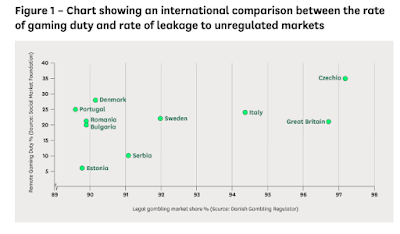 The vertical axis stops at 40%, which is below the committee's recommended tax rate, and two countries with higher tax rates are conspicuously absent. France and the Netherlands were both mentioned in the unfathomably influential Social Market Foundation report (which the committee cites) as countries to emulate. As the SMF says, "the Netherlands is changing its remote tax rate from 30.5% to 37.8% in 2025... And France has a remote sports betting rate of 55% – increased to over 59% in 2025." How are those two nations getting on? The situation in the Netherlands has been such a fiasco that the head of the SMF begged the committee to ignore it. The Dutch now do half their gambling on the black market, according to the Netherlands Gambling Authority. Meanwhile in France...
The vertical axis stops at 40%, which is below the committee's recommended tax rate, and two countries with higher tax rates are conspicuously absent. France and the Netherlands were both mentioned in the unfathomably influential Social Market Foundation report (which the committee cites) as countries to emulate. As the SMF says, "the Netherlands is changing its remote tax rate from 30.5% to 37.8% in 2025... And France has a remote sports betting rate of 55% – increased to over 59% in 2025." How are those two nations getting on? The situation in the Netherlands has been such a fiasco that the head of the SMF begged the committee to ignore it. The Dutch now do half their gambling on the black market, according to the Netherlands Gambling Authority. Meanwhile in France... Great success! Still, these are only real world case studies from near neighbours who have done more or less exactly what the Treasury Select Committee wants. What could we possibly have to learn from them?
France’s Illegal Gambling Market Surpasses Regulated Sector as Calls for Reform Grow France’s illegal online gambling market has overtaken the regulated sector for the first time, according to new data from the Association française des jeux en ligne (AFJEL). The group estimates 5.4 million players now use unlicensed websites generating about €2 billion in gross gaming revenue (GGR) in 2025 — a 25% increase since 2023.
November 6, 2025
Chris van Tulleken and the slippery slope
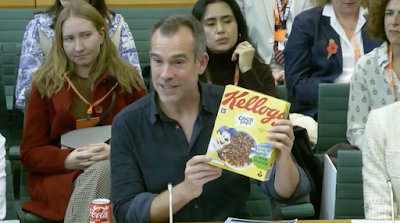
I suspect that if more people saw what goes on in Select Committee meetings there would be an armed insurrection. I've watched two recently, one from Canada where some insufferable politicians want to put cancer warnings on alcohol, and one in Britain where the Health and Social Care Select Committee is holding an inquiry into "food and weight management". This is how political pygmies distract themselves from the real business of government. Outside, prisoners are released by accident, the national debt is approaching three trillion pounds and the NHS consumes record funding to no great effect. Inside, politicians talk to idiotic nanny statists about "ultra-processed food". Economic growth has been essentially non-existent for years and the price of food has risen by 37% since 2020. And yet the Select Committee wants to tax food and ban advertising. To an outsider, this seems like a form of madness or a conspiracy against the public. It only starts to make sense when you realise that they all read the same things and listen to the same people. The Health Select Committee has had two days of hearings. Every single person who "gave evidence" is a zealot or a professional activist. There were three people from Jamie Oliver's front group Bite Back, two who used to work at the tiny pressure group Action on Sugar, two from the devious Food Foundation and one of the clowns from Nesta. None of the food industry's millions of satisfied customers appear to have been invited.
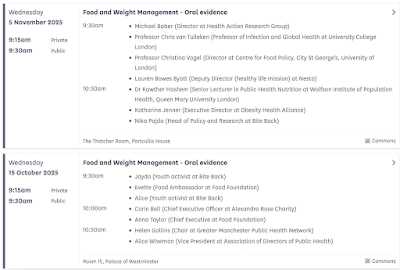 I didn't recognise any of the MPs and it was impossible tell which parties they represented because they all hold the same statist views. So did the witnesses, of course. This all gives the politicians the illusion of consensus which will only be shattered when their policies are implemented and the public becomes aware of them (look at the backlash against the ban on drink refills, for example, which is a far more modest measure than anything discussed by this committee). The star turn was Chris van Tulleken. Several MPs said how impressed they were by his ridiculous, error strewn book. One of the few positive things that can be said about van Tulleken is that he is upfront about what he wants. He brought along a pack of cigarettes, some wholegrain bread and a can of baked beans, products which he admits are "not entirely equivalent" but equivalent enough for him to want to do to food everything that has been done to tobacco.
I didn't recognise any of the MPs and it was impossible tell which parties they represented because they all hold the same statist views. So did the witnesses, of course. This all gives the politicians the illusion of consensus which will only be shattered when their policies are implemented and the public becomes aware of them (look at the backlash against the ban on drink refills, for example, which is a far more modest measure than anything discussed by this committee). The star turn was Chris van Tulleken. Several MPs said how impressed they were by his ridiculous, error strewn book. One of the few positive things that can be said about van Tulleken is that he is upfront about what he wants. He brought along a pack of cigarettes, some wholegrain bread and a can of baked beans, products which he admits are "not entirely equivalent" but equivalent enough for him to want to do to food everything that has been done to tobacco. He also made the important admission that health warnings are not really about giving people useful information but about demonising certain products so that more regulation and taxes can be applied to them. Again, the model is - quite explicitly and despite decades of slippery slope denial - tobacco. What will it take for the food industry to wake from its slumber?The prof confirms that the slippery slope is very real. pic.twitter.com/LoqwzGZ7HY
— Christopher Snowdon (@cjsnowdon) November 6, 2025
When asked if there are any food brands that would be allowed to advertise under his regime, van Tulleken struggled to think of any. He even claimed that "very credible nutrition academics" think that all food advertising should be prohibited.Van Tulleken says the quiet part out loud. He wants warning labels on food because it will start a cascade of taxes and regulation. #slipperyslope pic.twitter.com/4XVdtwraSp
— Christopher Snowdon (@cjsnowdon) November 5, 2025
“We should just not advertise food.” pic.twitter.com/1EEerV7gtF
— Christopher Snowdon (@cjsnowdon) November 6, 2025
Opinion differs on what drives van Tulleken's increasingly demented campaign against brown bread. Some say he is a grifter trying to sell copies of his book. Others say he is an attention seeker. My view has always been that he has an unhealthy relationship with food and suffers from orthorexia nervosa. He casually mentions in his book that he has been known to make himself vomit so he can eat more food, i.e. he has (or has had) bulimia, but seems to think that this is perfectly normal.
Giving evidence, he admits that he has the self-control of a six year old when it comes to ice cream. The video below is telling in several ways, not least in that he assumes that his experience is universal and that it is the fault of Big Food for making food too delicious. He reckons that ice cream, which has been around for centuries, is tasty because it is "engineered using brain scanners".Even if he were less wrong about the science and policy, this is not someone MPs should be listening to.Professor Van Tulleken bravely opening up about his eating disorder. pic.twitter.com/m8OwkBgjUb
— Christopher Snowdon (@cjsnowdon) November 6, 2025
November 5, 2025
Dewi Evans' unpublished letter to Private Eye
Private Eye's M.D. (Phil Hammond) is obsessed with the Lucy Letby case and has now published more than 30 lengthy (by Private Eye's standards) articles about it. They are getting rather repetitive so you'd think the magazine would be interested in some fresh content from someone who has an intimate knowledge of the case.
And yet when Dewi Evans, one of the key prosecution witnesses whom Hammond has bitterly attacked, wrote a letter to Private Eye, the editor chose not to publish it, although it did print a weird letter about the case from someone who inferred something from the way someone said something. Dr Evans has shared his letter with me and it is published below with his permission.
17 October 2025
Letters
Private Eye
The Editor
I am at a loss to understand Dr Phil Hammond’s excitable article in this week’s edition of The Eye, which relate to events surrounding the collapse and death of the infant known as Baby C.
The clinical facts are straightforward. Baby C was a tiny baby who was responding satisfactorily to treatment for pneumonia until his unexpected collapse. My preliminary report dated 7 Nov 2017 noted that “I have concerns regarding the unexpected collapse of [Baby C] at around 23.00 hr on 13 June 2015”. I added that “I would advise scrutinising the staffing present at the time”. Lucy Letby’s name as a ‘suspect’ was not known to me at the time, and there was no record of her presence in the infant’s clinical notes.
Cheshire Police’s attention to detail confirmed that the infant’s collapse occurred when in Lucy Letby’s presence, after the baby’s designated nurse had gone for a break. Lucy Letby’s involvement was noted in more detail in evidence given at the Thirlwall Inquiry [9 October 2024].
An x-ray taken 36 hours before the baby’s collapse noted a large ‘gas bubble’ in the stomach. The cause of the bubble has been the source of considerable discussion. Irrespective of its cause its presence cannot explain his collapse. Several clinical markers during the 36 hours after the x-ray was taken noted an encouraging improvement in his condition. His heart and breathing rates were within the normal range for a baby of his size. His oxygen saturations were in the high 90s. His oxygen requirements were falling, being just 25% just before his collapse. Encouragingly, he was deemed well enough to be taken out of his incubator for ‘skin to skin’ contact with his mother on the afternoon of his collapse and the day before.
An injection of air into the stomach would compromise the breathing of a tiny baby, quickly destabilising him. An injection of air directly into the bloodstream would be even more catastrophic. Whilst one cannot exclude the former the latter explanation is a more likely explanation for his collapse. One cannot rule out the possibility of his suffering from a combination of both. Either is indicative of inflicted injury, where the perpetrator would know that their action would place a vulnerable baby in harm’s way. This evidence led to the jury finding Lucy Letby guilty of the baby’s murder.
It's regrettable that Dr Hammond made no effort to get in touch with me prior to publishing his article. If he cares to get in touch with Cheshire Police, the CPS, or the Prosecution team, I am sure they would confirm the sequence of events I have described above, thus setting the record straight.
Sincerely
Dewi Evans
November 4, 2025
See you in Hell, European Alcohol Policy Alliance!
Eurocare AKA the European Alcohol Policy Alliance is a major part of the global temperance network established by Derek Rutherford. It has been kept afloat by unwitting taxpayers for years and is currently run by Florence Berteletti who used to run the Smoke Free Partnership (no slippery slope, eh?). Hopefully she is now out of a job and the Smoke Free Partnership will also be closed down because, as Politico reports...
Eurocare announces closure of its Brussels office amid funding difficulties
The Board of Eurocare have announced that due to constraints on its funding it will no longer be able to maintain an office in Brussels and will be letting go its paid staff members from the end of the year.
The Commission confirmed in July that it would be scrapping its operating grants — cash that goes toward daily overhead costs like staff salaries — for all health NGOs, despite signaling to many organizations that it would continue to fund them this year.Haha! Afuera! Although Eurocare claims to be "funded by a combination of membership fees and EU grants", it seems to have had only two donors last year: the European Commission and a Norwegian temperance group - and the Norwegian temperance group was overwhelmingly funded by the Norwegian government. The European Public Health Alliance has already bitten the dust after losing its EU grant (and everybody falling out with each other in its toxic workplace). The rest of these tax-spongers wowsers won't be far behind. In the UK, Alcohol Concern vanished as soon as its Department of Health grants were withdrawn and ASH have said that they would have to look at shutting down if their own DHSC grants were pulled. Isn't it strange that organisations which supposedly fight for popular causes can't survive on donations from the public? It's almost as if the general public don't consider lobbying for illiberal, killjoy policies to be a good cause at all!
November 3, 2025
The big lies of ASH
 ASH News
ASH NewsHazel Cheeseman, the head of Britain's most dishonest pressure group ASH, has taken to the pages of The Grocer to tell small retailers what is good for them. You might think that owners of convenience stores know their business and customers better than someone who has only ever worked in public affairs, but the say-anything, do-anything prohibitionists at ASH have long maintained that selling cigarettes is holding corner shops back. Cheeseman writes...
Big Tobacco is out in force telling retailers what to think about impending changes to the law.And the pot is out in force calling the kettle black.
As you may have heard, the government is phasing out the sale of tobacco to the next generation, which means by 2027 no one born before 2009 can be legally sold tobacco. We’ve all seen the articles and the adverts from tobacco manufacturers painting a picture of doom over these proposed changes. And behind the scenes, no doubt, there are countless emails, letters, and visits from company reps pushing the same message: that stronger tobacco regulation spells disaster for business. But the real burden on retailers isn’t regulation – it’s reliance on tobacco itself. Cigarettes might bring in footfall, but they deliver some of the lowest margins in retail, often just 6%. Smokers are quick, transactional customers; they buy their pack and leave.About 80% of the price of a pack of cigarettes is tax. The retailer obviously doesn't get a share of that. But if a pack of cigarettes is £15, a 6% share is 90p. Not bad for a quick transaction. Since the actual product only costs about £3, the pre-tax profit margin is 30%. If ASH wants retailers to have a bigger post-tax profit margin, it should call for tobacco duty to be cut.
By contrast, the same customers who quit smoking or switch to legal vapes tend to buy more, such as food to go, coffee, groceries and snacks. Every time that happens, both retailer and customer are better off.Ex-smokers obviously spend their money on other things. The problem for small retailers is that people can buy 'food to go', coffee, groceries and snacks in lots of places whereas smokers go specifically to local corner shops to buy their snouts. Most corner shops don't sell hot food and coffee at all. In any case, retailers are not so much worried about people quitting smoking as they are about smokers evading tobacco duty (and, in the future, bypassing the ridiculous generational ban) by buying cigarettes on the illicit market.
When display bans and plain packaging were first introduced, the same scare stories were rolled out. Yet the evidence tells a different story. ASH’s retailer survey, conducted by an independent market research firm with 900 small retailers, found 74% said the display ban had no negative impact or even helped their business, and 75% said the same about plain packs. Retailers adapted and carried on trading successfully.Neither of these stupid policies had an impact on the smoking rate, although the display ban did make it easier for retailers to sell illicit cigarettes. That was good news for some shops but presumably not for the legitimate businessmen who read The Grocer and who are losing a lot of money to a black market that ASH barely acknowledges the existence of.
Yes you are. You have to be to do your corrupt job.
The illicit trade myth At ASH we are not remotely complacent about the illegal tobacco market.
It brings crime into our communities, undermines legitimate trade and keeps people smoking. Illicit trade is a real issue – but it’s not caused by sensible regulation. In fact, illicit tobacco consumption has dropped by almost 90% since 2000-01, even as tax and regulation have tightened.If you believe that, you will be believe literally anything. Legal cigarette sales nearly halved between 2021 and 2024. The black market is quite obviously big and getting bigger.
The best way to end the illicit trade in tobacco, possibly the only way, is to end the demand for tobacco.Indeed it is the only way. But the Tobacco and Vapes Bill doesn't tackle demand. It is all about controlling supply, and we know what happens when supply is artificially restricted while demand remains high. The UK is already a cautionary tale, but Australia, with its even higher tobacco taxes and total ban on vapes, is the ultimate shipwreck that the rest of the world can use as a lighthouse. On the same day that Cheeseman's article was published, The Australian published this...
Amazingly, these retailers have not been selling enough coffee and 'food to go' to make up the shortfall.
Tobacco taxes backfire as black market cripples retail giants Australia’s two biggest supermarket chains have recorded a collapse in tobacco sales, blaming Labor’s aggressive tax hikes and the booming black market for hollowing out legitimate trade. Coles and Woolworths both reported more than 50 per cent declines in tobacco revenue over the past year – the sharpest fall on record – with the retailers saying cigarettes were priced so high that smokers have turned to untaxed, criminally supplied alternatives.
Woolworths revealed a 51.1 per cent plunge in sales for the first quarter, while Coles reported a 57 per cent decline, saying tobacco products now made up less than 2 per cent of total sales. “New tobacco legislation and growth in the illicit market led to a 57 per cent decline in tobacco sales compared to the prior corresponding period with tobacco sales this quarter now less than 2 per cent of total sales,” Coles noted in its first-quarter trading update.Nothing to see here, eh Hazel?
Woolworths chief executive Amanda Bardwell said the decline in tobacco sales was “accelerating” when asked about the plunging figures during her full-year results announcement. “We’re still navigating some near-term challenges, particularly the material reduction in tobacco sales,” she said.
“It’s been well-discussed by others, but the decline in tobacco sales is accelerating and the current regulatory settings, and continued illegal sales, is evident in our performance.”
The collapse follows The Australian’s investigation into the black market, which revealed convenience stores recorded a $2bn collapse in legal tobacco sales.It is frankly shameful that politicians and the British media have avoided mentioning the real world fiasco that has been unfolding in Australia while the Tobacco and Vapes Bill has been rolling through Parliament. The government pays more attention to the fabulist propaganda of ASH than to what is actually happening in another country.

Christopher Snowdon's Blog
- Christopher Snowdon's profile
- 6 followers



